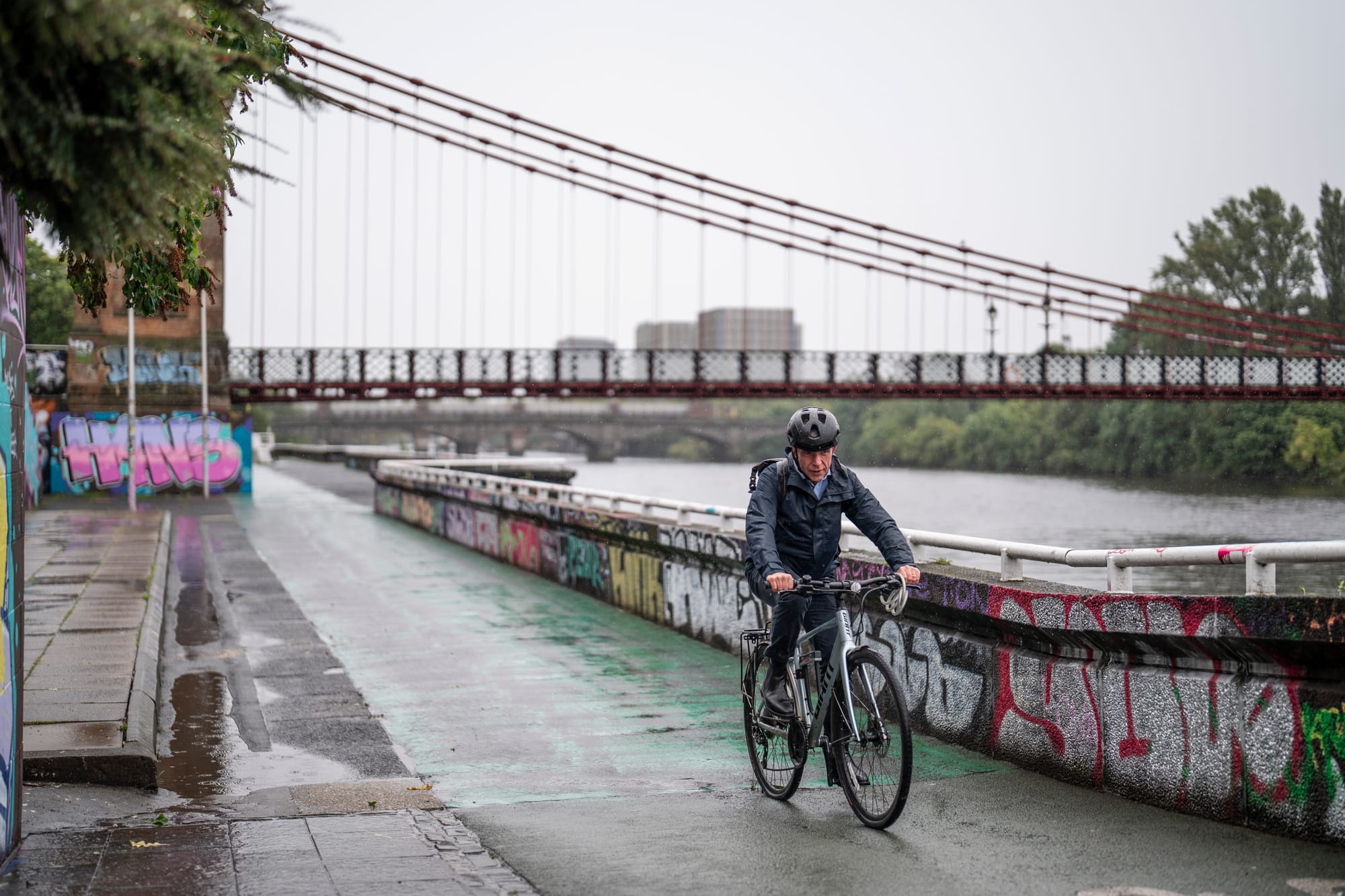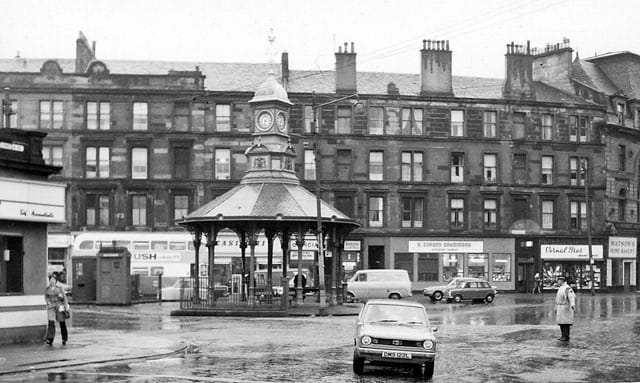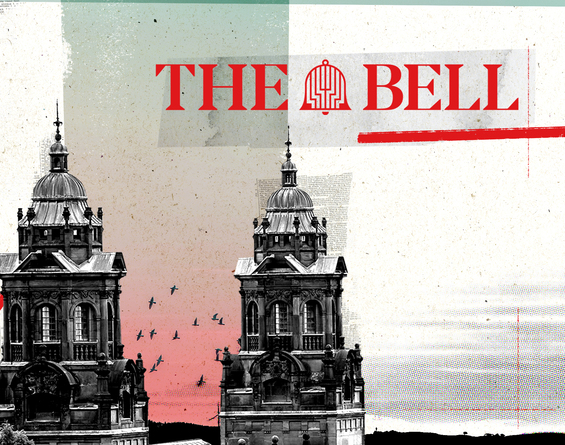When Andrew Hoolachan moved to Glasgow after a decade in London and Cambridge, he was immediately struck by the city’s rain. Even for a Dundee native, Glaswegian rainfall had a special quality, Hoolachan felt, as well as a constant boots-on, hoods-up volume. “It was the size of the raindrops,” he says. “And you could smell the Atlantic.”
That Glasgow is a wet city is not news to anyone. It is famously, and by far, one of the soggiest cities in the UK, collecting on average 1370mm from the skies every year, according to the Met Office. (Compare this to dry, flat Cambridgeshire, where average annual rainfall is 559mm.) A wetness of some kind drives downwards or sideways through most of Glasgow’s months, ranging from biblical downpours and torrential drumming to tiny rain-pins that bring what James Joyce called a “soft morning”.
As is true for Ireland, rain is hard set by Scotland’s mountainous topography, its western coast particularly prone to “Atlantic depressions” that extend the rainy seasons past their traditional autumn-winter peak, dampening the spring (and also, this year, the summer).
Hoolachan, a lecturer in Urban and Regional Planning at the University of Glasgow, wants Glasgow to see this as “an opportunity”. This autumn he will publish his research study, ‘Rain City’, funded by the Royal Town Planning Institute. The project will look at ways in which Glasgow could live better with its raininess, and improve urban design with downpours in mind. “We need a holistic approach to rain,” he says. “We need to acknowledge it.”
That starts at a conceptual level, Hoolachan says, reframing Glasgow entirely as a “city in a rainforest”, boasting of a lushness and greenness that is directly attributable to the wetness. “The whole west coast is a temperate rainforest. It’s humid and sticky, with lichens growing, but we’ve lost sight of that. When you’re walking around the city in the summer, you see green shoots coming out of the walls in the lanes. It really does come alive. It’s not like other cities.”
This could be celebrated, he says, with rain sculptures commissioned from artists, riffing on the excess water. Other rainy cities make the most of weather they can’t change, Hoolachan notes, citing Bergen in Norway as an example, where shops are named after the rain, and there is “city branding for the rain, rain in public art. Their motto is there’s only bad dress, not bad weather. Germans have that saying as well.”
Hoolachan says all this fully aware that rain in Glasgow is more often thought of as the opposite: a gloomy fixture, a nuisance, and often a hazard, pooling by traffic lights where you want to cross the road and undoing the tarmac. “I tripped over a pothole and nearly broke my ankle the other day,” he says ruefully. “The roads department is pretty bad. Glasgow City Council is obsessed with grand projects. I’m looking at granular issues.”
The council doesn’t keep data on pothole locations and timings, Hoolachan notes, nor does it seem to track where and when the city is flooding. Earlier this year, Glasgow was dubbed the “pothole capital of Britain” for racking up 61,000 reports of pothole damage in four years, at a likely cost of around £104m in outstanding repairs.

But still, this doesn’t change the fact there could be more positivity around rain, Hoolachan says. “No one is thinking about what the solutions might be about living with rain. People focus on flooding, but how do you create awnings for shop fronts, and threshold space — verandas, porches and porticos? Or rain gardens?”
One of his study’s cohort of volunteers, who accompanied Hoolachan on autumn “rain walks” in the Southside’s Queen’s Park to observe their interactions with the weather, said he even wished there were more covered spaces for birdwatching. Around Glasgow, there is a decent chance of seeing swifts, woodpeckers, skylarks, and maybe even some of the temperate rainforest birds, such as pipits or wood warblers.
The question of what might be missed in peripheral vision during a downpour had a different slant for another interviewee, however. One woman, Hoolachan says, preferred an umbrella to a hooded raincoat, because she felt a clearer sense of who might be walking up behind her.
Weather worries.
The first thing I do on any Glasgow day is look out the window to gauge the “coat consensus” — what the people already up and about seem to think the best guess is for the weather. No two days are the same. In her book 'Belonging', Glasgow School of Art lecturer and artist Amanda Thomson lists 62 words for rainy weather, sourced from 19th-century Scots dictionaries. “I was fascinated by the range and nuance to the spectrum, from dry to pelting to the aftermath of rainfall,” she says.
“From sapless, meaning dry; to heavy-heartit, low clouds threatening rain; a smurrack, a slight summer shower; to a down-ding, a heavy fall of rain. I think that speaks to not just the nature of the weather in Scotland, but how we’ve paid attention to it. There are so many words for types of wind also. Many of the Scots Language words, like a smirr, or a dreich day, feel so onomatopoeic too.”
In my years of living here, however closely I’ve tried to pay attention to the rain type, I’ve learned it’s almost impossible to dress successfully, short of buying 62 different raincoats. Hoolachan’s idea of a rainforest makes sense of this — that, actually, there is something almost tropical and wild about Glasgow, where the city and its inhabitants are more incidental to the landscape than we might think.
But the power of nature does creep into reality in other ways, which makes it harder to envision a city where the rain is an unequivocal delight. If it’s raining heavily, I tiptoe to the room at the back of my flat — or listen out for the unwelcome sound of rain plinking onto floorboards — already afraid that the most recent roof repairs of the tenement will not have held fast. More roofers, more big bills.

John McKinney of the Scottish Traditional Building Forum says that Glasgow’s huge stock of tenement flats, most of which were built before 1919, is not being cared for well enough to last another 150 years in good shape. This would wipe out buildings whose embodied carbon is low: erected with quarried local sandstone, not heat-fired bricks, and roofed with local slate and reinforced with slow-grown local timber. A crucial vulnerability of these buildings is the rain, which is likely to worsen in step with climate change.
“A minor repair that is not fixed becomes a big issue,” McKinney says. “When you have flash floods, the gutters aren’t big enough and the rains come over the side. Or you’ve got one slate that’s slipped on a roof, and the first thing that happens if the wind blows, it will lift up.”
He mentions the 2006 report by the British Geological Society on safeguarding Glasgow’s stone-built heritage. “The figures were frightening, and there’s been nothing done about it. The council is trying to work things out but it’s 18 years ago… we don’t seem to be addressing the fundamental problem.”
That is echoed by Jocelyne Fleming, Policy and Public Affairs Officer for Scotland at the Chartered Institute of Building, who lives in Glasgow. “The climate crisis will meet naturally ageing buildings. That’s the nexus,” Fleming says. This means the tenements have to be adapted, but she says there is “some debate in the industry about how to approach retrofit.”
In Fleming’s view, it starts with making buildings watertight and windproof. Others want to focus on energy sources, such as heat pumps. “Retrofitting social housing is especially challenging in Glasgow. For anyone in the tenement space, it is not easy at the moment to tackle repairs. With Scotland’s tenure system, because we have mostly freehold buildings, there isn’t by right or legislation funding pots of governance in place to agree repairs to a building. Some might be private-rented, housing association-owned, private-owned. There is an absence of a legal framework through which to address the repairs.”
In April, the Scottish Law Commission published a paper outlining how the tenement laws might be changed, to introduce compulsory homeowners associations. Such changes are slow. “Roofing tends to be a long protracted thing with your neighbours,” Hoolachan agrees. Meanwhile, it keeps raining.
Optimistic outlook.
The playwright Peter Arnott grew up in industrial Glasgow, a city that has now all but vanished. “I have a childhood memory from the ’60s, driving with my dad, watching men coming out of the shipyards in Clydebank, thousands and thousands of men in blue overalls,” he says. “Glasgow is not that place anymore. When I was a young teenager you couldn’t get a decent cup of coffee. Now coffee shops grow like mushrooms in the rain, you trip over them. Glasgow still clings to this picture of itself; this dark, rainy place.”
He describes a city that was “a different colour” before the soot of the tenements was sandblasted off. “It was black,” Arnott says. “I feel the city still hasn’t invented a new sense of itself. It’s pulling us backwards. The rain is a symbol of that.”
In Arnott’s 2000 play 'A Little Rain', two men, Michael and Phil, shelter in a pub during a downpour. They grumble about the rain, about life, and never quite set any of it to rights, before a dramatic twist intervenes. The work was commissioned to explore personal perspectives of post-devolution Scotland, a line that Arnott ran with bracingly to poke at what he sees as a national tendency towards moroseness. “The play was about self-pity as a defining Scottish characteristic: ‘Why does it always rain on me?’ The immediate response to devolution was whining.”
“Glasgow LEAKS, man, the hale city leaks....this is the roof repair capital of the WORLD....that’s the fucking game tae tell yer Daddy yer gettin intae. ‘Daddy, I’m gonnae be a SLATER’ and he will say ‘FUCK my dreams of Harvard, here’s yer scaffolding spanner and bless you my son!’”
excerpted from 'A Little Rain', Peter Arnott
The rain, for Arnott, is a neat but rich way to reveal character. “Weather happens to you, it’s a question of how you deal with it,” he says. “I think we’ve always rather enjoyed moaning about it. Everyone complains every summer. I’ve heard that since the 70s: ‘It’s the worst summer ever’.”
This means that Glasgow becomes hobbled by an on-off appreciation of the city, he says — literally, in the case of the “taps aff” tradition, in which (mostly) men whip off their shirts at the first sign of sunshine, and put them back on when it rains. “In Glasgow, you have trees out the window, it’s lovely to have them there, it’s gorgeous to have that life and space. The Glaswegian response is that you can only enjoy it when it’s not raining.”
Hoolachan believes the city’s relationship with itself as a rainy place could make more of a resilience that is already well established. “People have a reasonably high tolerance for discomfort. If it was raining for 10 minutes, for example, a lot of people would say it’s more important getting to the shops and getting some fresh air rather than worrying about getting a bit wet. We should be celebrating rain in Glasgow.”
Rain brought back lots of memories for his “rain walkers” too, though some of the recollections were of the business of drying off. Practical things like that remind Hoolachan “of not being able to dry clothes in the tenement”, he says.
There is a more poetic side to the subject, too. “Rain in summer is different; rain in the cold, rain in the wind, rain in the dark, even a wet city at night time, you see the reflections,” Hoolachan says. Rainwater may be a symbol of gloom, but it also was one of the first ingredients for making whisky, and a kind of endurance test for those moving from drier southern climes.
Arnott mentions the word petrichor, which means “the smell of hot pavement when it starts to rain”. “It was cloying in the 50s,” he says. “‘Petri’ comes from stone; ‘ichor’, blood of the gods. That smell of stone and blood of the gods. There’s an image for Glasgow.”
Comments
How to comment:
If you are already a member,
click here to sign in
and leave a comment.
If you aren't a member,
sign up here
to be able to leave a comment.
To add your photo, click here to create a profile on Gravatar.







